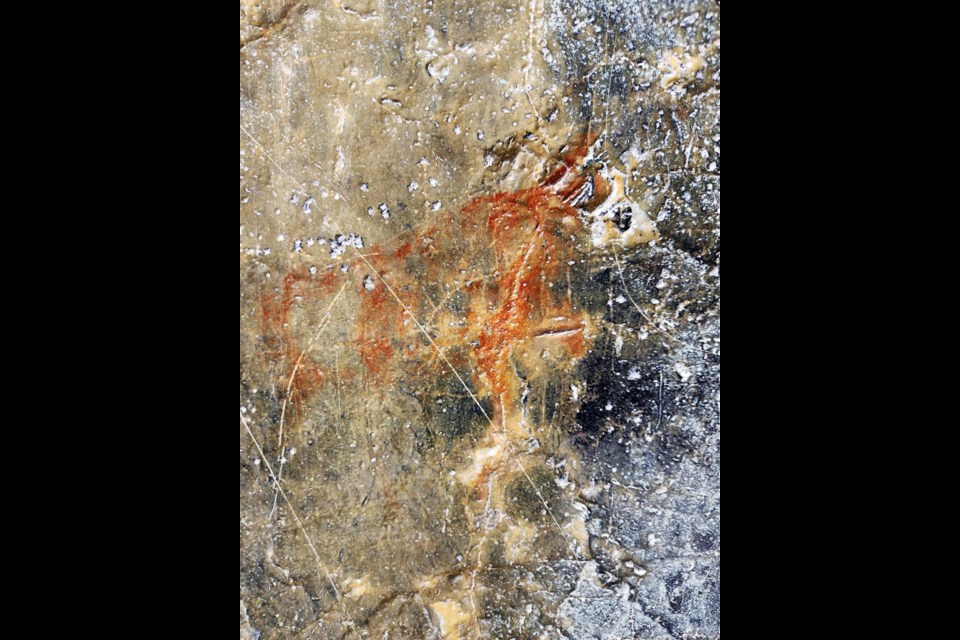CALGARY – A new book is highlighting Indigenous pictographs after 15 years of collaboration with elders.
Forgotten Dreams: A New Look at Ancient Rock Art Sites by Brad Himour explores and analyzes rock art sites created by Indigenous peoples, sometimes several centuries ago. Some of these sites, such as those in Grotto Creek Canyon, are located within the Bow Valley region.
“Grotto Canyon is one of the pictograph sites that I photographed and used a digital enhancement program called DStretch just to be able to show the elders better images,” Himour said. “Some of these pictographs are really fading. They are almost invisible to the naked eye, many of them are located in remote locations where the elders would not be able to get to them.”
“Using the digital enhancement really was beneficial in terms of the elders being able to see the pictographs much more clearly, and that allowed them to interpret the pictographs much better than they might have if we did not have enhanced photography.”
Himour explained in order to be able to accurately understand the meanings of the pictographs, elders must be consulted from Indigenous cultures responsible for creating them, as each culture preserves its own unique drawings and traditions.
Piikani, Shuswap Band, Îyârhe (Stoney) Nakoda, Ktunaxa, and Tsuut’ina were among, but not limited to first nation cultures consulted for the book.
Among the goals following the publication of the book is that the work being showcased will inspire more research, and interest from both Indigenous and non-Indigenous youth to speak with elders about the significance of these cultural sites.
“We know that many of the pictographs are centuries old, if not millennia. For example, there is a pictograph site at Cochrane Ranch Historic Site of what is called a shield-bearing warrior. Before the arrival of the horse on the plains, the shields were very large that were used by the Blackfoot Confederacy. In the pictograph, it covers almost from their toes up to their nose,” said Himour.
In other cases, such as the vertical series rock art on the northern Canadian plains studied by Michael Turney, it is believed some of those drawings date back between 2,000 and 2,500 years.
Many pictograph sites, particularly those of the Blackfoot First Nations, will depict Napi stories. Napi is a creator figure in Blackfoot culture, thus these pictograph sites serve as a direct connection between the people and the landscapes.
“Pictograph sites are actually more than just the rock painting, they are actually part of a cultural landscape. That pictograph that is painted in that particular area is there for a reason and the landscape is part of the overall story,” said Himour.
“That is what we learned from the elders was that really, the tradition of Indigenous storytelling has a lot of different reasons. It may record an important event that happened, it may record something like a vision quest or a spiritual journey, there are many different reasons why there are pictographs out on the landscape but it really ties together people and their culture and their landscape.”
Himour’s documentation of the pictographs was purposely non-intrusive to the original art, and physical samples were not collected from any of the sites.
He explained in speaking with the elders who collaborated on the project, they had expressed a preference that none of the sites be damaged or altered in any way.
The idea of using digital photography and enhancement to create permanent records of the sites in order to be passed on to future generations was more so the impetus of the project, as opposed to understanding the physical compositions and ages of the drawings.
“There were over 20 Indigenous elders who contributed to the book and for all of them, the main reason for their participation was the educational aspect. They would like this Indigenous knowledge that was passed on to them by their grandparents to be passed on to future generations,” said Himour.
Because petroglyphs, or rock carvings, do not enhance digitally very well, all of the pictographs featured in the book are rock paintings.
The paint which was used to create the images was typically made from ochre, which formed the base for the paint, and either bear or deer grease. Sometimes, particularly in the Shuswap, fish eggs would also be added to the mix for the paint.
To achieve fine detail in their rock paintings, rather than applying the paint with their fingers, a hollow reed would be used to blow the paint onto the rock instead.
Almost all of the sites featured in the book are within protected areas under Alberta Heritage Protection or British Columbia Heritage Branch Protection.
“I think the highest motivation or the most important aspect of the book, or participating in the project was the educational aspect for the elders. The Indigenous knowledge that is recorded in the book in the quotes of the elders, that is owned by the Indigenous elders, their families and their ancestors,” said Himour.
“We agreed to work together and they would share their Indigenous knowledge about these sites for the purposes of education and hopefully to inspire future research by Indigenous and non-Indigenous youth … by combining them together, our hope is that we encourage other communities to record their traditions regarding pictograph sites in their traditional territories.”
More information about the book, as well as to purchase a copy, can be found at www.forgottendreamspictographs.com. Copies of the book are also available at the Whyte Museum of the Canadian Rockies in Banff.



